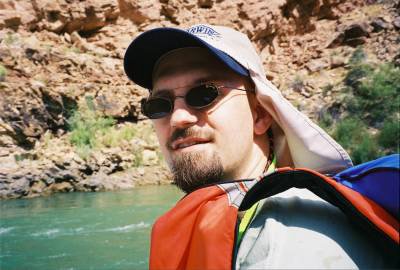Here is another repeat of a post I put out on the Milwaukee Evolution League blog years ago:
Creationists say that there's just no way such a little river as the Colorado River could have carved a canyon so very large. They insist that instead of a little water and a lot of time, the Canyon formed from a lot of water and a little time. But the fact is, neither of these polar opposites is the case. Rather, the Canyon formed with a LOT of water over a LOT of time.
One almost needs to have rafted the Grand Canyon to appreciate just how mighty the Colorado truly is. It's not just another waterway! It carries enough water through it to provide power to all of Las Vegas via Hoover Dam. It provides enough water to meet much of the potable water needs of Los Angeles, CA. This ain't no stream, folks! It's a fairly consistent gusher with a lot of power behind it.
But not only that, the river is rich in highly abrasive sediment. As one travels the river, the sediments can be so thick that you can't put your hand more than a couple of inches below the surface of the water before it can't be seen. When rafting the river, boatmen often put their canned beverages in a drop bag and throw it over the side in order to keep them cool. (In fact, the Colorado is deep enough to be quite frigid year-round, even in the hot Arizona sun!) But the sediments erode everything, including the beverage cans. If you leave your beverage in the river for too long, the abrasion of the river will strip the paint right off the can! If the paint is completely removed, rafters are left with the dilemma of trying to tell the difference between a can of Coca Cola and a can of beer! With erosion like that going on in the space of only several hours, imagine what millions of years could do! Perhaps the wonder of the Canyon is that it isn't significantly deeper. In fact, it probably would be much deeper, if a series of volcanoes along the North Rim hadn't dumped hot magma right into the middle of it about 15 million years ago.
That answers how the river cut such a deep canyon, but why is the canyon so wide? Could a river, no matter how mighty, have cut so wide a chasm when so comparatively narrow?
The answer is yes, for a number of reasons. First, canyons don't erode from the top-down. They erode from the bottom up. And when enough rock has eroded beneath, a rockfall from above ensues. This results in minor to major damming, forming new rapids or waterfalls, which erode very rapidly (thousands of years). Once level, the river cuts at a much slower rate. Also, occasional floods do occur with unusually large rainfalls on given years. During such periods, the river becomes much wider, erosion takes place much more rapidly, and more radical change takes place. It's wrong to look at the dry-season summertime Colorado River and say that such a "small" river couldn't have cut so wide a canyon.
Carrie Sager, daughter of Genie Scott, got to see this first hand on day three of the trip I took through the Canyon back on '05. During a heavy rainfall, a washed-off boulder fell and hit a side wall resulting in a large chunk of canyon getting knocked off into the river. It made a fantastic splash, and we all heard it, believe me! But Carrie was an actual eyewitness. What a story she got to tell!
It's very easy to accept that erosion made something so huge when you can actually see the rock widening right in front of your eyes.
Eric
Subscribe to:
Post Comments (Atom)



No comments:
Post a Comment